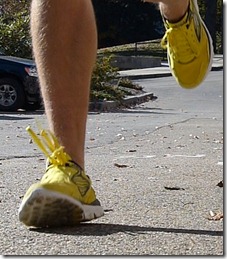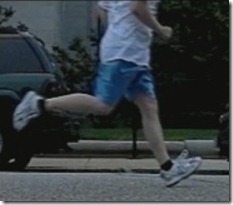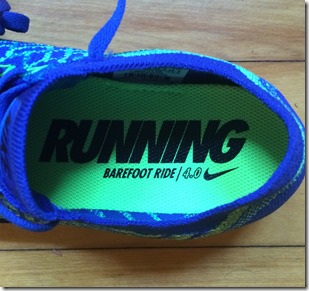 Last week I published a post where I invited you to play the role of Physical Therapist and evaluate my friend Lauren’s running gait. The response to that post was quite amazing, and we plan to do some follow-up filming outdoors with a local specialist later this week – stay tuned! One of the points I made in the intro to that post was that video analysis can be a great way to develop a mental picture of what you are doing when you run. However, when it comes to diagnosing problems with gait that might be causing some type of injury, it’s wise to enlist the help of someone who has clinical experience treating runners – it’s just as possible that you might do harm by monkeying around with your stride as it is that you might fix problems by forcing a change.
Last week I published a post where I invited you to play the role of Physical Therapist and evaluate my friend Lauren’s running gait. The response to that post was quite amazing, and we plan to do some follow-up filming outdoors with a local specialist later this week – stay tuned! One of the points I made in the intro to that post was that video analysis can be a great way to develop a mental picture of what you are doing when you run. However, when it comes to diagnosing problems with gait that might be causing some type of injury, it’s wise to enlist the help of someone who has clinical experience treating runners – it’s just as possible that you might do harm by monkeying around with your stride as it is that you might fix problems by forcing a change.
In a somewhat fortuitous coincidence, my friend Bill Katovsky recently forwarded me a piece written by Dr. Phil Maffetone on the pros and cons of video analysis in the treatment of running injuries. Phil has treated and coached many high caliber endurance athletes over the years, and writes extensively on topics related to health and fitness. A few months ago, I obtained a copy of his most recent book, The Big Book of Endurance Training and Racing – though I haven’t read it yet in its entirety, the book includes some great material on foot function, shoes, and running gait (naturally, I read those chapters in short order!).
Given its relevance to the post I put up last week, I asked Phil if I could re-post his piece on video analysis, and he happily agreed. The original version can be found here. Let us know what you think!
The Pros and Cons of Video Analysis: Getting the Runner’s Body Back in Balance
by Dr. Phil Maffetone
For the past several decades, video analysis of human movement has been used in virtually all sports by coaches, athletes, and healthcare professionals. Because of the relative ease of combining video and treadmill activity, this approach is now common in the evaluation of running gait. Properly applied, video analysis can be an important assessment tool, helping to reveal gait abnormalities and add to our knowledge and research of body mechanics.
In isolation of other factors, however, video gait analysis has limited value. An abnormal irregular gait pattern is most often the end result of some imbalance in the body or wearing improper shoes, and rarely due to just bad running posture. The ideal use of video analysis of gait combines it with a complete assessment including a health and fitness history, a thorough physical examination, and others such as blood and urine tests or x-rays that may be necessary to uncover a problem that influences gait, for a comprehensive evaluation of an individual.
Even to the untrained eye, it’s not difficult to observe an asymmetrical or awkward gait, even without a video—just watch other runners on the roads, track, or in parks. Fatigue can worsen most gait problems, so at the end of a 10K race or during the second half of a marathon, irregular gaits are more common and most obvious.
One must differentiate an abnormal, irregular-looking gait from one that is an individual’s normal running pattern. Regardless of your speed, running incorporates the use of more muscle mass than virtually all other regular activities. As such, one’s gait reflects individuality because the muscles (and their tendons) and bones (and associated ligaments) are not perfectly symmetrical between left and right side, and also vary from one person to the next. Like a unique “fingerprint,” this contributes to each person’s particular gait.
Other than the effect of wearing ill-fitting shoes, or those that have too much heel or are overly rigid, muscle imbalance may be one of the most common causes for an abnormal, irregular gait because the body’s neuromuscular system (including the brain, and nerves connected to the muscles) is responsible for all movement. For example, let’s say you pulled your right hamstring a few months ago, which caused weakness. A secondary problem might have developed as compensation—tightness in the right quadriceps. One possible end-result of this muscle imbalance is that the pelvis tilts downward on the same side and rotates forward, triggering tightness in the low back muscles. The result is an irregular gait—the right leg may stride slightly longer than the left, and the tension in the low back increases extension in the spine, distorting it all the way up to the head. (In addition to slowing you down at the same heart rate—the energy cost of running increases—you’ll fatigue easier and be at risk for an injury, typically one associated with inflammation in the hip, knee or spine.)
Video analysis won’t necessarily tell you which specific problem or imbalance exists, but rather, it provides images of how your body moves as a result of these particular imbalances. A common example of gait irregularity is associated with dysfunction of the tibialis posterior muscle, which is a frequent cause of foot, leg and knee injury. One end of this muscle attaches on the bones in back of the leg and the other end in numerous locations of the bottom of the foot. The tibialis posterior supports the medial arch, and significantly controls ankle and foot movements. Specifically, it stabilizes the back, middle and front of the foot while it’s on the ground during the run. A video analysis may demonstrate the abnormal gait associated with this muscle problem. The atypical foot mechanics associated with tibialis posterior muscle dysfunction may include excessive dropping of the medial arch—abnormal pronation—or other erratic motions observed when the foot hits the ground. After observing these movements on video, a follow-up assessment involves a precise evaluation of the tibialis posterior muscle (and perhaps other potential causes of the irregular gait) followed by an appropriate therapy that restores normal muscle function (such as the various techniques used in rehabilitation, physical therapy, or massage). In many cases, positive gait changes can be observed once the tibialis posterior muscle (in this case) is corrected, which can sometimes be in one or two treatments. In other cases requiring more therapy, a slower improvement in gait would follow.
But not everyone who pronates has this particular problem. Consider another runner with the same excessive pronation when the foot strikes the ground. In this case the cause of pronation may be dysfunction of the psoas muscle in the pelvis. The psoas attaches to the front of the lower spine, going through the pelvis and hooking on to the upper part of the inner thigh bone (the femur); and though it’s a primary flexor of the hip, it also affects leg rotation. Psoas dysfunction can result in the lower limb rotating outward too much causing the medial arch of the foot to fall excessively inward on impact—abnormal pronation. As often occurs after video analysis, by encouraging a runner to keep the leg from rotating too much, or point the toes more forward rather than too far out may seem logical, but this can put significant stress on other muscles potentially triggering an injury in a different location, such as a muscle strain that affects the knee joint. Just as important, if this is the only recommendation, the psoas dysfunction remains untreated.
A video analysis of your gait can have the greatest value if a trained professional performs the test and interprets the images. There are individuals with diverse educational and professional backgrounds who are experts in this field, including kinesiologists, physical therapists, medical doctors, chiropractors and others engaged in sports medicine. But the video is only part of what is often a complex process—a full evaluation might include postural analysis, physical examination, blood tests, and assessment of other aspects of your life that could directly or indirectly impact on gait. This might also include exercise schedules, diet, nutritional status, and the types of shoes you wear during sport, leisure, and work.
Physical therapist Jay Dicharry, Director of the SPEED Performance Clinic and the Motion Analysis Lab Coordinator at the University of Virginia, uses three-dimensional motion analysis systems in his state-of-the-art facility to digitally reconstruct the individual’s body as a multi-segment system. In a recently published paper in the journal, Clinics in Sports Medicine (2010), he describes part of this assessment procedure: “After infrared markers are placed at specific anatomic landmarks, their position is triangulated by cameras to calibrate the individual into the system. Construction of the coordinates and orientation of the rigid body segments allow calculation of joint angles of the proximal and distal segment, joint angular velocity, and joint acceleration. Measurements are collected for each joint in all three cardinal planes of motion.” The 3D gait analysis then produces graphs for each plane of motion of each specific joint. Dicharry also states that, “In a clinical setting, barefoot gait evaluation can yield a plethora of information about the foot, but clinicians must be aware of the complex foot mechanics.”
Just as important as a complete gait assessment is an athlete’s follow up. After a video analysis, and following any therapy or exercise recommendations that are made to improve your gait, another assessment should be made to observe whether improvements in gait have indeed occurred. How soon this is performed after the first video analysis depends on the individual and his or her particular problems. And most importantly, all this should correlate with any previous signs or symptoms—a prior injury should be completely gone if the process has been successful.
Video analysis of gait is too often used to help an athlete run more “efficiently.” In this case, the runner’s gait is compared with some textbook or “ideal” style, and the recommendations might include lifting the knees higher, swinging the arms differently, bending forward more, or, as mentioned above, preventing the lower limb from rotating outward too much. Put into practice by the runner under the watchful eye of his or her coach this approach can be counterproductive and can even lead to further dysfunction. I’ve seen too many athletes, even elite runners and professional triathletes, who tried to mimic a so-called “perfect” running gait—one that uses a world class marathoner’s gait as a model—only to get injured more, along with worsening performance. One reason is that the causes of an irregular gait—such as muscle imbalance—are never evaluated and corrected. Instead, the person consciously runs with a different gait, which can further add stress to an already imbalanced body. Correcting abnormalities must be done first. This will allow the brain to better regulate muscle, joint and other mechanical function to provide the most efficient gait for that particular individual. (Another problem with trying to copy the fluid form of a world-class marathoner is that most people simply can’t run that fast.)
Other key factors in video analysis of gait are cost and availability. The equipment in a modern gait laboratory might include a three-dimensional motion analysis camera system, a high-tech treadmill with special force platforms and pressure mats, and video editing software necessary to compile the images. But this type of facility is less available to the average runner, who more often is evaluated with a simple camera on a basic treadmill, which has its limitations. However, in many cases, a proper gait analysis using modern high-tech equipment with follow up can cost significantly more than visiting the right therapist who may be able to effectively assess and treat the causes of irregular gait without the need for video analysis.
Here are some other thoughts if you’re ready to have your gait analyzed. In quantum physics it’s been said that the mere act of observing an atomic particle changes it’s state—in video analysis, when someone, or a group of individuals, is watching you run, you will usually, perhaps subconsciously, change your gait. In addition, running on a treadmill, where you are not moving but instead, the “ground” is, can present a slightly different gait compared to the same pace or intensity when on a track, for example. In this instance, the quadriceps muscles work a bit harder than when on a track. This could also slightly alter your gait. Of course, being on a typical road, or trail is most obviously different than a treadmill gait.
Like most assessment tools for use on humans, video analysis of gait is not perfect. But the science of observation—a key part of my work with athletes since the 1970s—would not be the same without the large volume of important research that has been performed, often by assessing the running gait.
This is not to say there aren’t ways to make the running gait more mechanically and metabolically efficient. Physical strain and wasted energy can come from excessive arm movement, overstriding or other improper movements. But these issues should be addressed after other imbalances are assessed, treated, and re-evaluated, and even before this, finding the proper shoe that best matches your feet. But in many cases, addressing such issues as muscle imbalance and proper footwear can also eliminate many bad habits.
Despite the many possible benefits of video, the simplest, least expensive and most effective approach for most runners to experience a better gait is to just take off their shoes and run a short distance slowly while barefoot. (A barefoot video analysis of gait is the “raw data” that’s vital before seeing the body while wearing shoes.) Just jogging barefoot down the hall in your home is a start. Doing this on a smooth surface, such as an outdoor track or grass for a couple of hundred meters is helpful. A daily “therapy” of jogging barefoot—even working up to a quarter mile—can be great for the feet and overall body mechanics. In addition to this routine having the potential to correct muscle imbalance, it enables one to immediately experience how natural running truly feels—something a video analysis usually won’t accomplish. There’s nothing high-tech about going barefoot; and yet it can do wonders in improving a runner’s gait.
One elite runner, Dr. Mark Cucuzzella, 43, is a highly accomplished marathoner (2:24 PR), race director, family physician, Associate Professor at West Virginia University School of Medicine, Lieutenant Colonel in the Air Force Reserves, and owner of Two River Treads, a Center for Natural Running and Walking, in Sheperdstown, West Virginia. He is a big believer in video analysis and barefoot running. “I have been enlightened in how not just my own body works and how to correct it, but also in how I can assist others, by participating in gait evaluation and the corrective prescriptions with Jay Dicharry at his SPEED Performance Clinic. Jay has taught me to see and understand what I could not see. The analysis which involved motion and joint forces helped me identify asymmetries, joint mobility and stability deficits, and stride patterns which were sub-optimal for efficiency. By cueing certain movements and muscles I made immediate corrections in form and through proper rehabilitation of weaknesses made long-term stability corrections. Retesting proved in the lab what I was feeling in my body — a more relaxed, stable, and efficient stride. That being said I continue to learn and am doing a lot of true barefoot running now and it’s really impossible to overstride barefoot. The lower leg never gets out beyond perpendicular to ground.”
We too often forget that the human body, when given the opportunity and in the proper environment, is the best teacher and coach. We just need to be more attentive students.



















Speak Your Mind